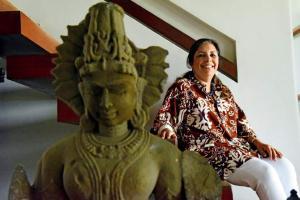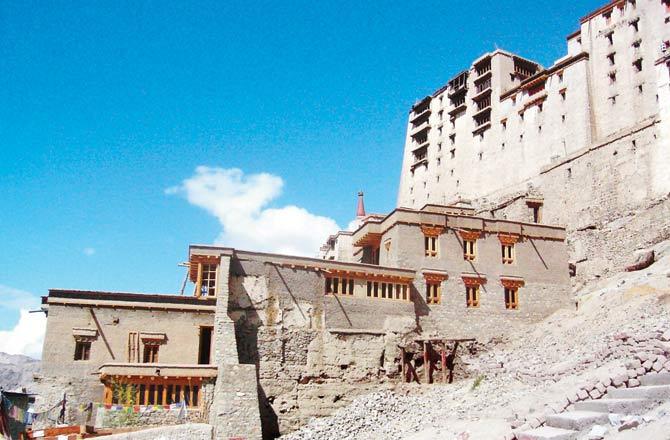The story of how Mumbai-based anthropologist Dr Monisha Ahmed and countless Ladakhis transformed a 17th-century site into a cultural hub, winning a UNESCO honour

Dr Monisha Ahmed. Pic/Rane Ashish
John (Harrison, British architect) and I would drop by bars in Leh to collect used plastic and glass bottles. If someone were to open up the roof of the LAMOor Ladakh Arts and Media Organisation Centre (lamo.org.in) in future, they will be in for a surprise!" laughs Dr Monisha Ahmed when we meet her at her Juhu home.
Nearly 2,500 km away in Leh, the 17th century site she is discussing, comprises two structures — the Munshi House and Gyaoo House — restored by her, Harrison and a team of Ladakhis. For it, the group was recently honoured with the Award of Distinction at the UNESCO Asia Pacific Awards for Cultural Heritage Conservation.

Among those Mountains - Nine contemporary artists from Ladakh, exhibition opening, LAMO, 2014
Over the next hour, LAMO's co-founder and executive director offers a virtual tour, recalling ideas like the bar-hop that was essential to source material that would insulate the restored building from the unforgiving winter. But extremities don't rattle Ahmed. She is familiar with the terrain since she was an anthropology student.
Over the last 30 years, her fascination has grown into a full-blown mission to contribute towards the region's socio-cultural and economic fabric.
The slideshow she shares ends with a vibrant frame from a bird festival at LAMO. The idea of a living, breathing arts and media centre in Leh's Old Town, has taken flight, and Dr Ahmed is happy with the results.
Edited excerpts from the interview.

John Harrison
How did the love affair with Ladakh start?
I've been visiting Ladakh since the 1980s. As a student of anthropology from St Xavier's College, the region intrigued me. Despite my parent's concerns, a friend and I made the long journey via train, bus and air. Later, research subjects for my MPhil and DPhil programmes in Social Anthropology drew me closer to its lifestyle, art and culture and diverse legacy. I've lived with nomads for days. I was keen to direct this knowledge constructively for the region and its people.
How did the LAMO Centre find a home?
LAMO was formed in 1996-97 by fellow anthropologist Ravina Aggarwal and myself as a platform to support the arts, culture and media in Ladakh. We were also keen to set up a resource centre to execute these ideas, in a manner that will highlight the value of the revitalisation of a heritage site. In 2003, I was introduced to Harrison, who was already working in the area on a project funded by INTACH, UK. He was also investigating the possibility of restoring Munshi House nearby. It seemed like an ideal site to house our community arts centre. After meeting the owners, Dr Angchuk Munshi and his father, Ishay, we had a potential site on hand, but since the library and exhibition areas couldn't be accommodated, the neighbouring Gyaoo House was included after its owner, Stanzin Gyaltsen agreed to the same terms. Long-term leases were drawn for both houses, and work began in 2005. We completed the project in 2010. Today, both owners are commended for their foresight because they leased their homes to an NGO and took a risk.

The Munshi House was a mud brick architectural structure built in the 17th century, possibly the second most important site of the Old Town after the Leh Palace
How were funds raised despite lack of support from authorities?
We sourced a lot of material available on site like fallen stone or earth from collapsed roofs. Cement and concrete was avoided – we wanted to demonstrate how local material and methods still work, so we relied on these, and willow and poplar wood. Probably, the costliest part was labour. It's twice as expensive here as in the rest of India. The project was privately funded – through my personal sources and some private donations raised by me. The conservation of the wall paintings in a room we have called the Fire Place Room – the last segment of restoration completed last year – was supported by a grant from the Kalpataru Trust, Mumbai.
What was your toughest challenge?
From the short working season to Ladakhi craftsmen approaching the project hesitatingly assuming that the site was haunted, challenges were many. We had to procure building materials at the start of the season (Leh faces shortages if the passes open late) or store supplies a year in advance before the winter set in. Each passing year meant increasing costs. In 2006, one of the large, elaborately decorated rooms in Munshi House collapsed during a storm; fortunately, it collapsed inwards and we were able to pick up the pieces and restart.

In terms of scale with several art works and minimalist woodwork showcasing a vernacular style but also influences from Kashmir, Tibet and Central Asia
Why did you nominate the LAMO Centre? What does this UNESCO honour mean?
Restoration work in the fire place room was completed in 2017, and so we felt the time was right. Conservation architect Vikas Dilawari had suggested that we nominate the site after a visit. We hope this award will bring attention to Ladakh's heritage. This is not the first time a UNESCO award has come here, but the earlier two buildings were religious. This is a private site, so hopefully, it will highlight houses and local architectural forms, help draft heritage laws and enable the local government to step in and disallow questionable beautification and rampant commercialisation. Leh remains one of the last Himalayan towns that retain its character. With the INTACH Chapter having opened in 2010, more awareness must be created among Ladakhis to reuse and restore rather than destroy.
Have you been involved in any Mumbai's culture and heritage?
I used to work as projects director, INTACH Greater Mumbai from 1997 to 2000. During this time, INTACH had established a site museum at Elephanta Caves; we also had an art auction to raise money for funds for the site. The Dr Bhau Daji Lad Museum restoration project was just starting when I left for my work in Leh. Naturally, I learnt a lot from Tasneem Mehta, former INTACH convener. In 2017, I was advisor for We Wear Culture, a fashion and textile design project as part of the Google Cultural Institute.

Layering of plastic and glass bottles on the roofs was suggested as an idea from a student project as insulation
Why the LAMO Centre matters
The region has many heritage monuments and private homes that require conservation. Ignorance, changing weather patterns and development projects led to negligence; the worst case being the knocking down of sites completely. LAMO is the result of successful and sensitive preservation of a heritage structure. A question that tends to arise in such cases is what happens to a site after restoration? This centre is a firsthand example of offering varied initiatives to the youth in particular. Ladakh has a very high literacy rate (approximately 80%). We have been able to offer them a platform to explore their interests, create avenues to earn their livelihood and contribute towards society.

Situated just below Leh Palace, the rooms of LAMO look out from over the city of Leh

Construction of library. Alignment of beams and pillars, redoing of roofs, flooring and rooms, brought with it obstacles and unique hurdles

LAMO Centre staff and artists with Dara Shikoh Trust members, Bird Festival, Sept'18. Tashi Morep (first row, first from right)
Catch up on all the latest Mumbai news, crime news, current affairs, and also a complete guide on Mumbai from food to things to do and events across the city here. Also download the new mid-day Android and iOS apps to get latest updates
 Subscribe today by clicking the link and stay updated with the latest news!" Click here!
Subscribe today by clicking the link and stay updated with the latest news!" Click here!









